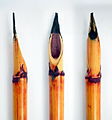Writing tube
The write pipe or tube spring , even Kalamos (from gr. : Κάλαμος, pl κάλαμοι Kalamoi; Latin calamus, pl calami...) Or Qalam ( Arabic قلم, DMG qalam ), is a writing instrument made from reed ( Phragmites australis ), possibly also from calamus ( Acorus calamus ), which was used throughout ancient times .
The ancient world already knew Kalamoi made of metal ( bronze ). One of the oldest known specimens is a bronze calamos, which together with a papyrus scroll in a grave from the 5th century BC. Was found in Attica ( Greece ). The use of bird feathers as a writing instrument is used in ancient times not. Mentioned in literature before the 6th century AD. Chr.
handling
The natural tube is cut at an angle, the tip split. It is written in ink on papyrus or parchment . Because of the rapid wear and tear, the natural tube often has to be trimmed while writing. With the diagonally cut Bourdon tube - by varying the angle of the hand and arm - lines of different thickness and thickness can be written.
Importance in the Orient
In the Orient, the Qalam is considered the finest of writing implements . It remained in use here until modern times . It is the most important writing instrument for Arabic and Hebrew script and their calligraphy .
The Qalam (in Persia with the Qalam-kar ) was also used for the ornamental lettering of fabrics and carpets, especially in folk art .
Importance in Islamic theology
The Qalam also plays an important role in Islamic theology. It is mentioned four times in the Koran ( Sura 3 : 44; 31:27; 68: 1; 96: 4), of which twice in early Meccan times. In sura 96 , which Muslims consider to be the earliest sura, it says:
"Carry out! For it is your Lord, the honored one, who taught with the pen, taught people what he did not know. "
While the traditional Muslim exegetes see here an allusion to the art of writing as an artistry taught by God to man, Angelika Neuwirth assumes that a heavenly pen is intended here. Such a heavenly pen is also assumed by the traditional Muslims in the opening verse of sura 68, which is referred to as the "sura of the pen " ( sūrat al-qalam ):
"Now. By the pen and what they write down! You (i.e. Mohammed) are not possessed thanks to the grace of your Lord. "
The writing tube of which we are speaking here is said to have been created before everything else and what is written with it is to be divine predestination , denoted in Arabic by the term Qadar . This interpretation was based on an explanatory hadith that was traced back to the Prophet through various channels of tradition. In the version quoted by Jafar ibn Muhammad al-Firyābī (d. 913) in his Kitāb al-Qadar , it reads:
“The first thing that God - exalted and mighty is - created is the pen. Then he created the nūn, which is the inkwell. Then he said to him (sc. The pen): 'Write!' It asked, 'What should I write?' He replied: 'That which will happen and will be until the day of resurrection.' That is the speech of God (sc. In the Koran): 'Nūn. By the pen and what they write down! ' He then sealed the mouth of the pen so that it could no longer speak. Then he created the mind. And he said (to him): "I will make you perfect with the one I love. And I will make you imperfect with the one I hate."
As Josef van Ess has shown, such hadiths were deliberately spread about the heavenly writing tube in the 8th century in the theological debate with the Qadarites by followers of Predestinian views.
literature
- Horst Blanck : The book in antiquity (= Beck's archaeological library ). Beck, Munich 1992, ISBN 3-406-36686-4 .
- Otto Mazal : Greco-Roman antiquity (= history of book culture. Volume 1 ). Academic Printing and Publishing Company, Graz 1999, ISBN 3-201-01716-7 .
- Cl. Huart, A. Grohmann: Ḳalam. In: The Encyclopaedia of Islam. New Edition . Volume IV, p. 471.
- Anton Spitaler : al-Qalamu aḥadu l-lisānaini (= contributions to the lexicography of classical Arabic ). Beck, Munich 1989, ISBN 3-7696-1550-6 .
Web links
supporting documents
- ^ Peter Lamborn Wilson : Weaver of Tales. Persian Picture Rugs / Persian tapestries. Linked myths. Callwey, Munich 1980, ISBN 3-7667-0532-6 , pp. 9-13, here: p. 68 (“Qalam-kar fabrics”), 85, 174 f. and more often.
- ↑ Rudi Paret : The Koran. Commentary and Concordance. 4th edition. Stuttgart 1989, p. 515.
- ↑ Angelika Neuwirth: Early Meccan Suras. Poetic prophecy. Berlin 2011, p. 270.
- ↑ Ǧaʿfar ibn Muḥammad al-Firyābī: Kitāb al-Qadar . Ed. ʿAbd al-Munʿim Salīm. Dār Ibn Ḥazm, Beirut 2000, p. 29f.
- ↑ Josef van Ess: Between Ḥadīṯ and Theology: Studies on the Origin of Predestinian Tradition . de Gruyter, Berlin et al. 1975, pp. 77-79.


